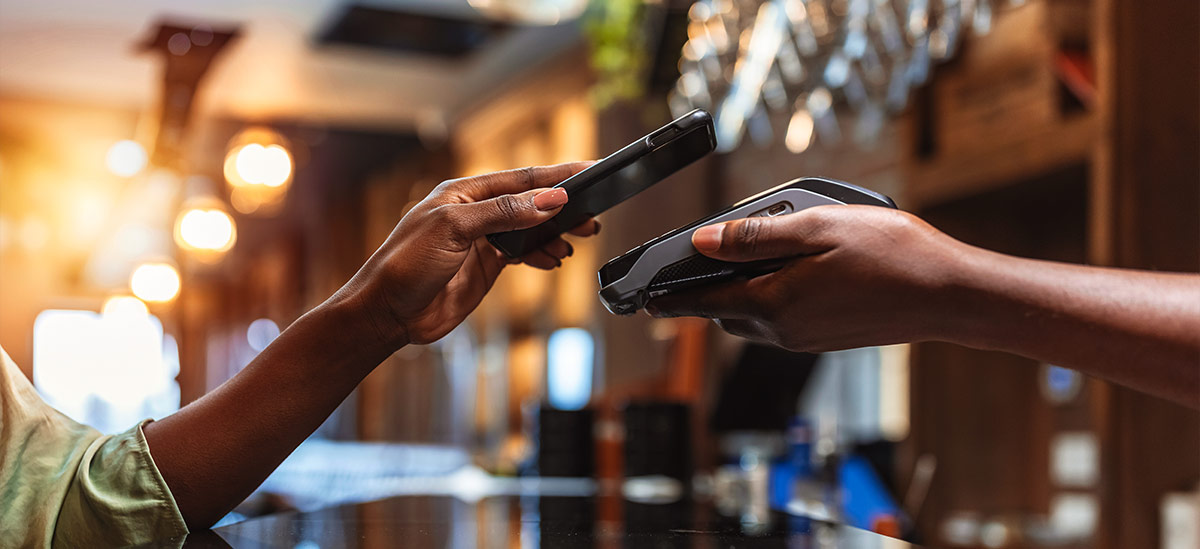
Imagine heading out for a busy day of running errands, shopping, and dining without having to carry your purse or wallet. Mobile wallet technology is a convenient way to make all your payments with a tap of a smartphone or smartwatch.
Whether you’re grabbing coffee, hopping on the subway, or picking up groceries, a mobile wallet can provide a streamlined, speedy, and secure payment experience.
If you’ve never heard of a mobile wallet, our experts are here to help. Let’s take a look at the basics and the answers to some commonly asked questions.
What Is a Mobile Wallet?
A mobile wallet is essentially a digital version of your physical wallet, designed specifically for use on mobile devices like smartphones and smartwatches. It’s a feature that’s often already pre-loaded onto these devices, including those sold by Apple®, Samsung™, and Google™.
Mobile wallets store payment information with modern security features and allow you to conduct transactions with a tap of your device. They also enhance security and mitigate fraud by encrypting your data, to prevent payment details from being directly shared during transactions. A mobile wallet is a digital way to use your credit, debit, ID, gift, and loyalty cards so that purchases can be made using a mobile phone rather than a physical card.
How Do Mobile Wallets Work?
Whether you use a mobile wallet that has already been pre-installed or choose to install a third-party app, adding your financial information is straightforward. Typically, it involves the cardholder manually entering card details into the wallet app or scanning the card with the device’s camera. The information is stored and encrypted securely for future transactions.
When making in-store purchases, mobile wallets use near-field communication (NFC) or a QR code to facilitate payments. These contactless methods offer the convenience of tap-to-pay at a compatible terminal, eliminating the need to physically swipe or insert a card. Contactless also provides several extra layers of security, for example, by requiring you to enter a PIN or use a biometric on your mobile device before tapping your device. For online purchases, digital wallets can be used depending upon the methods of acceptance enabled by the merchant.
Mobile wallets are popular, in part, due to their advanced security features. These include:
- Encryption: Transforming card details into a complex code that can only be deciphered by an authorized system. This guards sensitive data against potential cyber threats, ensuring that it remains unreadable and secure even if data is intercepted.
- Tokenization: Replacing card account info with alternative account info (tokens) that are unique to you and your device, and then computationally generating a sequence of one-time-use dynamic hexcharacters (cryptograms) that are unique to each transaction. These tokens have no value outside your device, which helps prevent their use by hackers if they were fraudulently accessed.
- Biometric Authentication: Using methods like fingerprint or facial recognition ensures that only the valid device owner can authorize transactions through their mobile wallet. This prevents unauthorized access and transactions if the device ends up in the wrong hands.
Benefits of Mobile Wallets
Mobile wallets offer a range of advantages that make them an increasingly popular choice for managing financial transactions. Here’s are some of the primary benefits users enjoy.
1. Convenience
Mobile wallets allow you to carry all your eligible payment cards digitally, eliminating the need to carry a physical wallet. For life on the go, having everything you need inside your mobile device makes it easy to make purchases, whether you’re buying online or in-store. Mobile wallets also provide continuity of payments, allowing you to continue using even if your physical plastic card is lost or stolen.
2. Speed
Transactions with mobile wallets are typically faster than traditional payment methods. At checkout points, tapping your device near the payment terminal is quicker than swiping a card or handling cash. This can enhance the shopping experience, reducing time spent at the register.
3. Enhanced Security
Features such as encryption, tokenization, and biometric authentication provide more security than physical cards or cash. The added security safeguards your sensitive information, allowing you to make purchases with confidence, knowing your card information is not shared with the merchant. If your phone is lost or stolen, biometric authentication helps prevents someone else from using your mobile wallet, and real-time connectivity allows permitted parties to remotely disable the wallet at the valid user’s request.
4. Organization
Mobile wallets simplify the management of multiple cards and loyalty programs. Instead of carrying numerous cards for different purposes, they can be neatly organized in your mobile wallet. This declutters your physical wallet, making it easier to access and use loyalty cards and coupons. That way, you don’t miss out on rewards and discounts. You can also track all of your transactions from a single place.
Popular Mobile Wallets
Mobile wallets are becoming more common, with a few options currently dominating the market. If you own one of the popular smartphone brands, it’s likely already pre-loaded with one of the following:
- Apple Wallet and Apple Pay®: Available on Apple devices, such as iPhones and Apple Watch, Apple Wallet is an integrated app that stores your credit and debit cards, and loyalty cards, allowing you to use them with Apple Pay.
- Google Wallet and Google Pay™: Android users often have access to Google Wallet and Google Pay. Google Wallet stores various cards and integrates seamlessly with Google Pay for quick and secure transactions.
- Samsung Wallet and Samsung Pay™: Samsung Galaxy devices come preloaded with Samsung Wallet, incorporating Samsung Pay. This wallet is tailored to Samsung devices, offering a range of features, including loyalty card storage and convenient payment options.
PNC Bank customers with eligible Android™ devices also can use PNC Pay, which is integrated into the PNC Mobile app. It allows you to use your PNC Visa consumer or small business credit and debit cards to make secure payments at various locations.
In addition to these brand-specific wallets, several third-party mobile wallets are available. They are often compatible with a wide range of devices, making them appealing to a diverse user base.
Mobile Wallets vs. Digital Wallets
While mobile and digital wallets are closely related, they have distinct differences. Mobile wallets, like Apple Pay, Google Pay, and Samsung Pay, are designed specifically for use on mobile devices such as smartphones and smartwatches. They are ideal for contactless in-store purchases, offering convenience and enhanced security through NFC technology.
Digital wallets have a broader scope. They can be accessed on various devices, including desktop computers and laptops. While mobile wallets are a subset of digital wallets, their use is specifically tailored to mobile and wearable devices for on-the-go payments.
Explore Your Mobile Payment Options
Mobile wallets offer a blend of convenience, security, and efficiency, changing the way we handle transactions.
There are several types of digital and mobile wallets available, with each offering its own unique features and benefits.
If you're ready to streamline your payment methods, now is the perfect time to start exploring your options. Start today by learning more about PNC Bank's mobile banking experience.




